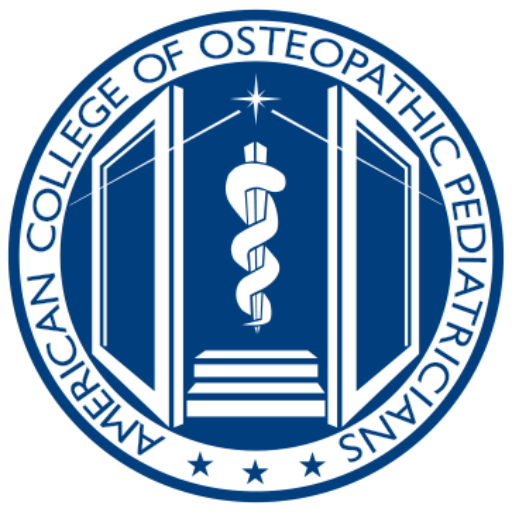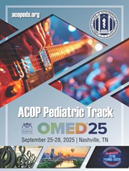The American College of Osteopathic Pediatrician’s (ACOP) eJournal is the premiere peer-reviewed online journal for osteopathic pediatricians and trainees. The ACOP eJournal is published exclusively online in a quarterly format.
Priority is given to manuscripts that highlight ideas, topics, research, and education specific to osteopathic pediatricians.
Physicians-in-Training (Fellows, Residents, Interns, Medical Students) are highly encouraged to submit their manuscripts and help to shape the future of our profession. A scholarly Mentoring program is available to Physicians-in-Training who would like guidance writing their manuscript, assistance with the submission process, or need an attending author for their manuscript.
Submission Process
All submissions to the ACOP eJournal must be through our new online manuscript and review platform. Manuscripts and accompanying materials will be uploaded through the site by the author, and authors will receive correspondence about their submissions through the site or by email. A manuscript will be considered for editing and publication once all required files are submitted (incomplete submissions will not be processed). The status of submissions can be checked on online at anytime.
Manuscripts should be submitted as Microsoft Office Word with line numbers and need to format in 12-point standard font (i.e. Arial, Calibri) and include all required components. CLICK HERE for complete Submission Content Requirements with additional requirements, suggestions, and tips.
Abbreviations need to be defined within each manuscript at the time of their first use. Generic names of medications are encouraged (unless a study is investigating a particular brand name medication). Reference should be formatted in the standard American Medical Association (AMA) format.
Previous Publication and Simultaneous Submission
The ACOP eJournal will not consider submissions that have previously been published or are concurrently being considered by other journals.
Manuscript Categories
Each category contains, where relevant, recommended limits for word count, number of references, and number of tables or figures. These limits should be seen as a helpful guide for authors as they prepare their manuscripts. Manuscripts that exceed the suggest limits may be considered for publication with or without the editorial suggestion that the author shorten their manuscript. Since the ACOP eJournal is an online publication, the recommended limits are more for readability and accessibility of the published articles.
Original Research: These include original clinical or applied research such as controlled trials, survey-based studies, observational studies, and quality improvement studies. Authors must provide documentation of the decision from the author’s institutional review board for all investigational studies. Original research should include an abstract, introduction, methods, results, discussion, and conclusion section. Authors are encouraged to submit figures and tables. . Word limit: 4,500. Abstract word limit: 250. Figures/Tables: No more than 10. References limited to: 50.
Quality Improvement Studies: These submissions should examine a current area of need either locally within a specific system or more globally within the area of Public Health and Advocacy. A specific area of need should be identified and a process by which to address this area (e.g. PDSA cycles) should be discussed. Submission in this category can be descriptive of processes that have been completed or projects that are ongoing and being iteratively reviewed and revised based on the current presentable data. Word Limit: 4500. Abstract Work Limit: 250. Tables/Figures: no more than 10. Reference limit: 50
Reviews: This section includes systematic reviews, meta-analyses, topic reviews, narrative reviews, and clinical reviews. These manuscripts summarize and analyze published research that relates to a particular clinical question or topic. Reviews need to include a clear introduction to the topic, a detailed description summarizing the evidence, and a conclusion with identifiable take-home points and future implications. Word limit: 4,500. Abstract word limit: 250. Figures/Tables: No more than 8. References limited to: 75.
Medical Education: This section invites authors to describe and discuss a variety of educational and biomedical topics of interest to osteopathic pediatricians including unique perspectives related to health care and delivery, medical education, and career development. Word limit: 2,500. Figures/Tables: No more than 4. References limited to: 30.
Case Series and Case Reports: This section focuses on newly recognized or rarely reported clinical scenarios. Submissions for cases are encouraged to provide images stripped of all patient-identifying information. Each manuscript should include: an introduction to the specific disease/topic, a detailed description of the patient’s medical course (from presentation through diagnosis to treatment and outcomes), a summary of how this case differs from what has been reported in medical literature to date, and a conclusion. Word limit: 2,500. Abstract word limit: 250. Figures/Tables: No more than 10. References limited to: 50.
- A case series: includes a collection of several patients’ with similar findings and reports. The manuscript should provide pertinent details of each case. These cases may report unusual or rare findings, but authors’ are also encouraged to submit common findings if they present a teachable lesson.
- A case report: includes a clinical case that the author felt had significant educational value, such as a common disease that presented in an unusual way, in addition to rare cases or findings.
Manuscript Components
Cover letter – Each submission must include a cover letter addressed to the ACOP eJournal Editorial Board. The following information must be included in the cover letter: Full names, title, affiliations, and contact information for the Corresponding Author, Lead Author, and Supporting Authors should be included. The article category and key take-home points should also be included in the cover letter.
Title page – The title page needs to include the title of the manuscript, the authors’ full names with their titles and affiliations, author contributions, and any financial disclosures. Doctoral and master degrees should be listed (osteopathic medical students should include the title “OMS” plus the year in training, ie “OMS III”), as well as full professional titles for each author. Author’s contributions need to be identified using language provided by the International Committee of Medical Journal Editors: “[Author(s)] provided substantial contributions to conception and design, acquisition of data, or analysis and interpretation of data; [Author(s)] drafted the article or revised it critically for important intellectual content; [Author(s)] gave final approval of the version of the article to be published; and [Author(s)] agree to be accountable for all aspects of the work in ensuring that questions related to the accuracy or integrity of any part of the work are appropriately investigated and resolved.” For financial disclosures, a simple statement of “None of the authors have any potential conflicts to disclose” will suffice. In the event that there may be conflicts, then a financial disclosure statement with the grant number, employment, description of funding, stock ownership, or other potential conflict of interest needs to be explicitly stated.
Abstract – Abstracts are required for manuscripts submitted in every article category with the exception of Medical Education submissions. Educational Communication. Abstracts have a suggested word limit of 250 words, and should include the following sections: objective, methods/findings, results, and conclusions.
Manuscript – Each manuscript should follow the suggested word limits listed and include the sections outlined in the corresponding article category. The institutional review board that approved the project must be clearly identified within the body of the manuscript for any human or experimental animal investigation. The manner in which informed consent was obtained from human subjects must also be clearly stated.
Acknowledgments – The authors are welcome to acknowledge anyone whom they felt contributed to their research or the preparation of the manuscript. Acknowledgements should be full names, professional titles, degrees earned, and affiliations. It is the authors’ responsibility to notify anyone who will be acknowledged in their manuscript.
References –Authors are required to appropriately reference all information, facts, data, and ideas that come from other sources. The references need to follow the guidelines from the 11thedition of AMA Manual of Style: A Guide for Authors and Editors (2020).
Graphic Elements – tables, and figures should be simplified and clear with their axes clearly labeled. Clinical images, illustrations, and figures need to be submitted in a high-resolution JPEG, PNG, PDF or TIF file with any patient-identifying information removed. All graphic elements need to have a caption that describes that particular element. Accurate citations and permission to reprint or adapt any graphic elements must be clearly documented so as not to infringe upon any copyright protected material. Authors are responsible for obtaining and providing such written permission. Photographs of patients must be accompanied by a written permission to use the photographic images in your manuscript from the patient or the patient’s legal guardian (if patient is under 18 years of age.)
Manuscript Formatting for Submission
All submissions should be submitted as Microsoft WORD document with line numbers, formatted in a 12-point standard font (i.e. Arial, Calibri) and include all required components.
Graphic elements (tables, figures, images, illustrations, and figures) should be included in the Word document and subsequently uploaded in the next section of the submission platform.
Tips/Reminders:
- You MUST remove any identifying information (institution name, investigators, etc.).
- Font recommendations are Arial or Calibri, 12-point standard font.
- Submissions should follow the AMA style, especially references.
- Authors must refer to original documents rather than secondary sources.
- Citations within your manuscript should be numbered and in parenthesis, ex. (1), (2), etc.
- Confirm that you have included all required components for your submission type
Peer Review and Publication Process
All manuscripts submitted to the ACOP eJournal in full according to the guidelines detailed above will be reviewed by a minimum of two reviewers. The reviewers are typically experts in the subspecialty field associated with the manuscript. The ACOP eJournal notifies authors of the decision made by the reviewers within 90 days: accept, accept with minor revisions, reconsider after major revisions, request to work with mentor on revisions, or reject. Authors are encouraged to contact the ACOP eJournal if they have not heard about a decision on their manuscript by that time.



